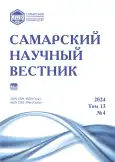Влияние постоянного магнитного поля на метаболизм и жизнеспособность магнитных биосорбентов на основе дрожжевых клеток
- Авторы: Беспалова С.В.1, Легенький Ю.А.1, Яицкий А.С.2
-
Учреждения:
- Донецкий государственный университет
- Самарский государственный социально-педагогический университет
- Выпуск: Том 13, № 4 (2024)
- Страницы: 14-19
- Раздел: Биологические науки
- URL: https://bakhtiniada.ru/2309-4370/article/view/284621
- DOI: https://doi.org/10.55355/snv2024134102
- ID: 284621
Цитировать
Полный текст
Аннотация
Исследовано повреждающее воздействие магнитной маркировки наночастицами магнетита и постоянного магнитного поля на жизнеспособность, метаболизм и магнитные свойства магнитомаркированных дрожжевых клеток, которые могут быть использованы как магнитоуправляемые биосорбенты с пассивными и активными механизмами биосорбции. Магнитные свойства магнитомаркированных клеток оценивались методом весов Фарадея. Показано, что магнитная восприимчивость магнитомаркированных клеток возрастает при увеличении концентрации железа, приходящегося на 1 клетку (CFe), и не изменяется в течение нескольких суток для клеток, культивируемых в постоянном магнитном поле и без постоянного магнитного поля. Повреждающее воздействие на жизнеспособность исследуемых дрожжевых клеток оценивалось по разности относительной доли живых клеток в популяции в начале и конце их культивирования. Количество живых клеток оценивалось методом окрашивания метиленовым синим и подсчетом окрашенных клеток в камере Горяева. Показано, что повреждающее воздействие магнитной маркировки в исследованном диапазоне CFe не зависит от CFe при культивировании без постоянного магнитного поля и возрастает с увеличением CFe при культивировании в постоянном магнитном поле. Метаболизм магнитомаркированных клеток оценивали по выходу протонов из дрожжевых клеток в ходе переработки ими глюкозы (тест подкисления). Показано, что магнитная маркировка снижает интенсивность выхода протонов из клетки не более чем на 30%. Таким образом, в данной работе показано, что при использовании магнитной маркировки наночастицами магнетита можно получать жизнеспособные дрожжевые клетки с парамагнитной восприимчивостью. Такие магнитомаркированные клетки можно использовать как магнитоуправляемые биосорбенты, которые могут осуществлять пассивную и активную биосорбцию токсикантов и при этом эффективно отделяться с помощью магнитных сепараторов от очищаемой среды.
Полный текст
Открыть статью на сайте журналаОб авторах
Светлана Владимировна Беспалова
Донецкий государственный университет
Email: bespalova@donnu.ru
доктор физико-математических наук, профессор, ректор
РоссияЮрий Анатольевич Легенький
Донецкий государственный университет
Email: yu-legen@mail.ru
старший научный сотрудник научно-исследовательской лаборатории магнитобиологии кафедры физиологии и биофизики
РоссияАндрей Степанович Яицкий
Самарский государственный социально-педагогический университет
Автор, ответственный за переписку.
Email: yaitsky@sgspu.ru
старший преподаватель кафедры биологии, экологии и методики обучения
РоссияСписок литературы
- Balintova M., Estokova A. Materials for heavy metals removal from waters // Materials. 2024. Vol. 17, iss. 9. doi: 10.3390/ma17091935.
- Zinicovscaia I., Yushin N., Grozdov D., Rodlovskaya E., Khiem L.H. Yeast – as bioremediator of silver-containing synthetic effluents // Bioengineering. 2023. Vol. 10, iss. 4. doi: 10.3390/bioengineering10040398.
- Sieber A., Jelic L.R., Kremser K., Guebitz G.M. Spent brewer’s yeast as a selective biosorbent for metal recovery from polymetallic waste streams // Frontiers in Bioengineering and Biotechnology. 2024. Vol. 12. doi: 10.3389/fbioe. 2024.1345112.
- Veglio F., Beolchini F. Removal of metals by biosorption: a review // Hydrometallurgy. 1997. Vol. 44, iss. 3. P. 301–316.
- Diep P., Mahadevan R., Yakunin A.F. Heavy metal removal by bioaccumulation using genetically engineered microorganisms // Frontiers in Bioengineering and Biotechnology. 2018. Vol. 6. doi: 10.3389/fbioe.2018.00157.
- Лыков И.Н., Гаранин Р.А., Петрухина Д.И. Использование биомассы микроорганизмов для извлечения тяжелых металлов из сточных вод // Экология урбанизированных территорий. 2018. № 3. С. 60–63. DOI: 10.24411/ 1816-1863-2018-13060.
- Faraji M., Shirani M., Rashidi-Nodeh H. The recent advances in magnetic sorbents and their applications // Trends in Analytical Chemistry. 2021. Vol. 141. doi: 10.1016/j.trac. 2021.116302.
- Солопов М.В., Легенький Ю.А., Беспалова С.В., Холявка М.Г. Биосорбция ионов тяжелых металлов дрожжевыми клетками, модифицированными наночастицами магнетита // Вестник Воронежского государственного университета. Серия: Химия. Биология. Фармация. 2019. № 1. С. 96–102.
- Diaz-Ravina M., Baath E. Development of metal tolerance in soil bacterial communities exposed to experimentally increased metal levels // Applied and Environmental Microbiology. 1996. Vol. 62, № 8. P. 2970–2977. DOI: 10. 1128/aem.62.8.2970-2977.1996.
- Гаранин Р.А., Лыков И.Н. Исследование возможности использования дрожжей (Saccharomyces cerevisiae) в качестве биосорбента тяжелых металлов из промышленных сточных вод // Вестник Московского государственного технического университета им. Н.Э. Баумана. Серия Естественные науки. 2008. № 1 (28). С. 110–119.
- Zablotskii V., Polyakova T., Dejneka A. Cells in the non-uniform magnetic world: how cells respond to high-gradient magnetic fields // BioEssays. 2018. Vol. 40, iss. 8. doi: 10.1002/bies.201800017.
- Bae J.-E., Huh M.-I., Ryu B.-K., Do J.-Y., Jin S.-U., Moon M.-J., Jung J.-C., Chang Y., Kim E., Chi S.-G., Lee G.-H., Chae K.-S. The effect of static magnetic fields on the aggregation and cytotoxicity of magnetic nanoparticles // Biomaterials. 2011. Vol. 32, iss. 35. P. 9401–9414. DOI: 10.1016/ j.biomaterials.2011.08.075.
- Dobosz B., Gunia E., Kotarska K., Schroeder G., Kurczewska J. The effect of a magnetic field on the transport of functionalized magnetite nanoparticles into yeast cells // Applied Sciences. 2024. Vol. 14, iss. 4. doi: 10.3390/app 14041343.
- Турчин В.В., Лёгенький Ю.А., Солопов М.В., Попандопуло А.Г., Беспалова С.В., Фисталь Э.Я. Магнитофоретические свойства фетальных фибробластов человека, маркированных суперпарамагнитными наночастицами оксида железа, стабилизированными цитратом // Гены и клетки. 2017. Т. 12, № 1. С. 47–53.
- Беспалова С.В., Кладько Д.В., Легенький Ю.А., Павлов В.Н., Глазунова В.А. Влияние низкочастотного переменного магнитного поля на жизнеспособность магнитомаркированных клеток Saccharomyces cerevisiae // Актуальные вопросы биологической физики и химии. 2019. Т. 4, № 3. С. 335–339.
- Sigler K. Acidification power (AP) test and similar methods for assessment and prediction of fermentation activity of industrial microorganisms // Kvasny prum. 2013. Vol. 59, iss. 7–8. P. 204–208. doi: 10.18832/kp2013021.
Дополнительные файлы









